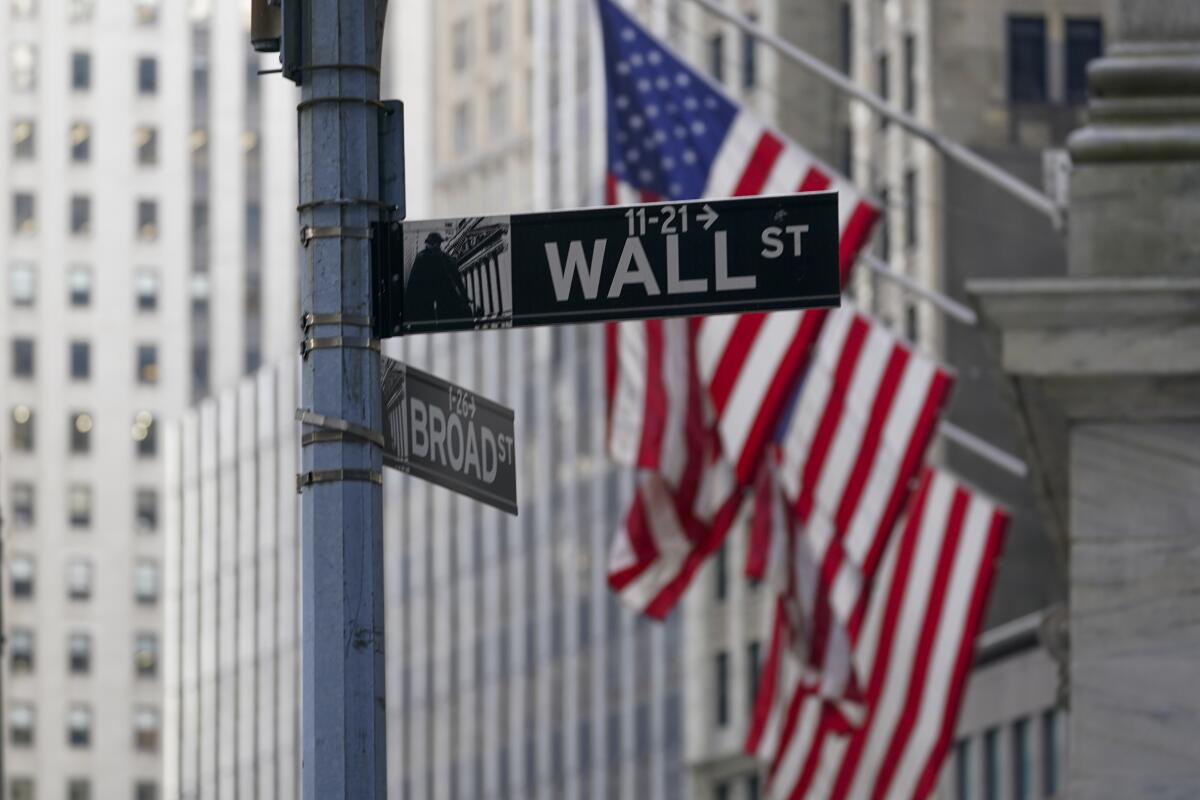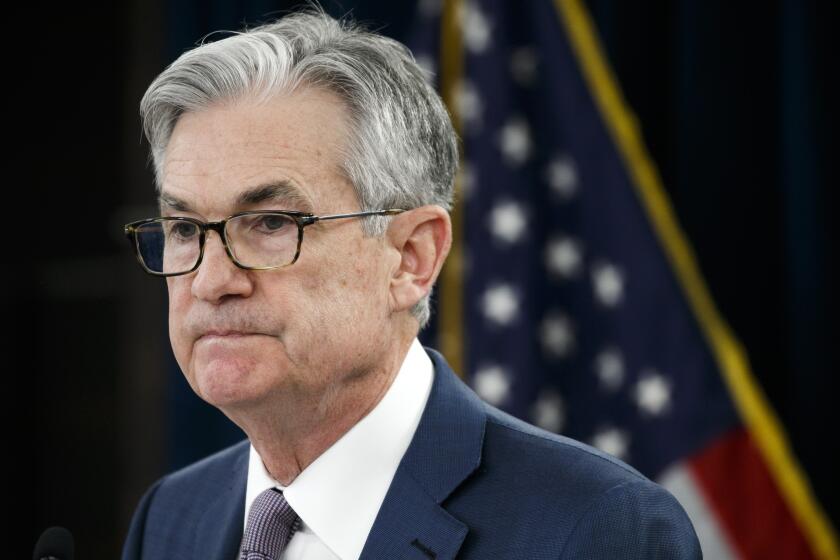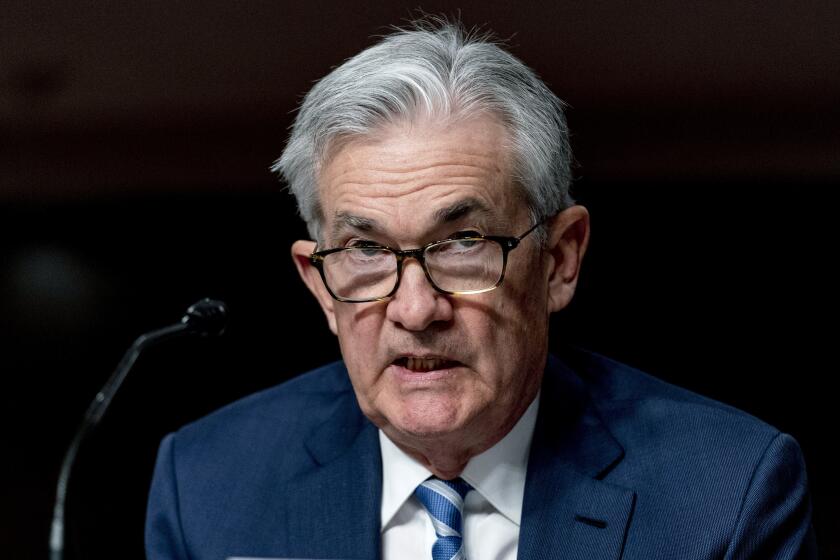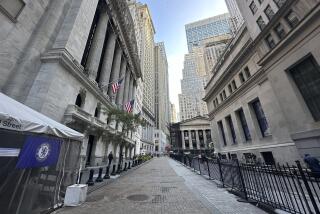Stocks fall and yields rise after Fed prepares to hike interest rates in March

- Share via
NEW YORK — An early market rally on Wall Street gave way to a broad slide for stocks and a surge in bond yields Wednesday after the Federal Reserve signaled it plans to begin raising interest rates “soon” to fight a surge in inflation that the central bank says is probably getting worse.
The Standard & Poor’s 500 index fell 0.1% after having been up 2.2% earlier in the day. The Dow Jones industrial average fell 0.4% after swinging more than 900 points from its high for the day. The Nasdaq composite ended little changed, shedding most of a 3.4% gain.
Bond yields rose, including the yield on the 10-year Treasury note, which climbed to 1.87% from 1.78% late Tuesday. Yields affect rates on mortgages and other consumer loans.
In a statement issued after its latest policy meeting, the Fed said it “expects it will soon be appropriate” to raise rates. Such a move is expected to happen as soon as March, as half the Fed’s policymakers have expressed a willingness to raise rates by then. The Fed also said it would phase out its monthly bond purchases, which have been intended to lower longer-term rates, in March.
The major stock indexes initially rose after the 2 p.m. Eastern time release of the Fed statement, but shed most of their gains as Fed Chair Jerome H. Powell took repeated questions about how and when the central bank will start letting its balance sheet shrink after buying trillions of dollars of bonds through the pandemic.
The Federal Reserve struck a hawkish tone as it signaled its readiness to raise interest rates in March.
The selling accelerated as Powell acknowledged that the high inflation slamming the economy isn’t getting better, which could force the Fed to get even more aggressive about raising interest rates and removing the support it put in place for markets.
“Since the December meeting, I’d say the inflation situation is about the same but probably slightly worse,” he said. “It hasn’t gotten better. It’s probably gotten just a bit worse, and that’s been the pattern.”
Powell also said that there’s room to raise interest rates without hurting the labor market, and wouldn’t rule out the possibility that the central bank could raise short-term interest rates at any one of its meetings this year or raise rates by a larger-than-usual amount.
Those comments sent a signal to Wall Street that the Fed may be more hawkish when it comes to tackling inflation, said Willie Delwiche, investment strategist at All Star Charts.
“In the market’s mind, that’s more rate hikes, and while he was clear to say that the economy is strong enough to handle those rate hikes, from a strictly [stock] market perspective, higher rates weigh on expensive stocks,” Delwiche said.
The S&P slipped 6.52 points to 4,349.93. The Dow fell 129.64 points to 34,168.09. The Nasdaq rose 2.82 points to 13,542.12. The indexes are all on pace for weekly losses.
The market had been solidly higher before the release of the Fed statement, which followed several days of volatile swings as investors try to gauge whether the Fed will succeed in its new effort to fight inflation. The central bank had been widely expected to continue drawing back its stimulus measures before raising interest rates in the coming months.
Federal Reserve Chair Jerome Powell said the Fed will raise rates more than it now plans if needed to stem surging prices.
Inflation pressure on businesses and consumers is what‘s driving the Fed to raise interest rates this year. There was some concern on Wall Street that Powell could suggest that the central bank will raise interest rates this year more than the four times that most economists currently expect.
For nearly two years, investors had poured money into stocks, confident that the Federal Reserve would help keep share prices upright. With that support going away, markets have been hit with volatility. The S&P 500 is down 9.5% this year.
Markets rose after the Fed’s last policy meeting in mid-December. It wasn’t until three weeks later, in early January, that stocks turned jittery. That’s when minutes released from that meeting suggested Fed policymakers may be more zealous about fighting inflation through higher interest rates than many had been expecting.
Investors knew that higher rates were on the way, but the minutes showed that the Fed was likely to raise rates faster than in prior efforts to get rates back to normal. Perhaps more effectively, the Fed also said it was likely to be quicker than in the past to reduce the huge holdings of bonds it had bought up through the pandemic to keep longer-term interest rates low. That would have an effect similar to additional rate increases.
All but two of the sectors in the S&P 500 turned lower, with communication, healthcare and industrial stocks weighing down the index the most.
Strong earnings reports and financial forecasts underpinned gains for some stocks. Microsoft rose 2.8% after reporting standout results for its latest quarter on solid demand for its cloud-computing services and work software. Chipmaker Texas Instruments rose 2.5% after giving investors a solid earnings report and financial forecast.
Investors are also gauging the threat from COVID-19 and the Omicron variant’s effect on economic growth. The International Monetary Fund cited the Omicron variant as the reason it downgraded its forecast for global economic growth this year.
Wall Street is also carefully watching the potential conflict between Russia and Ukraine, which could push energy prices higher and force nations to focus on a war just as they are trying to focus on keeping the pandemic in check, along with economic growth.
— Associated Press writer Stan Choe contributed to this report.
More to Read
Inside the business of entertainment
The Wide Shot brings you news, analysis and insights on everything from streaming wars to production — and what it all means for the future.
You may occasionally receive promotional content from the Los Angeles Times.












